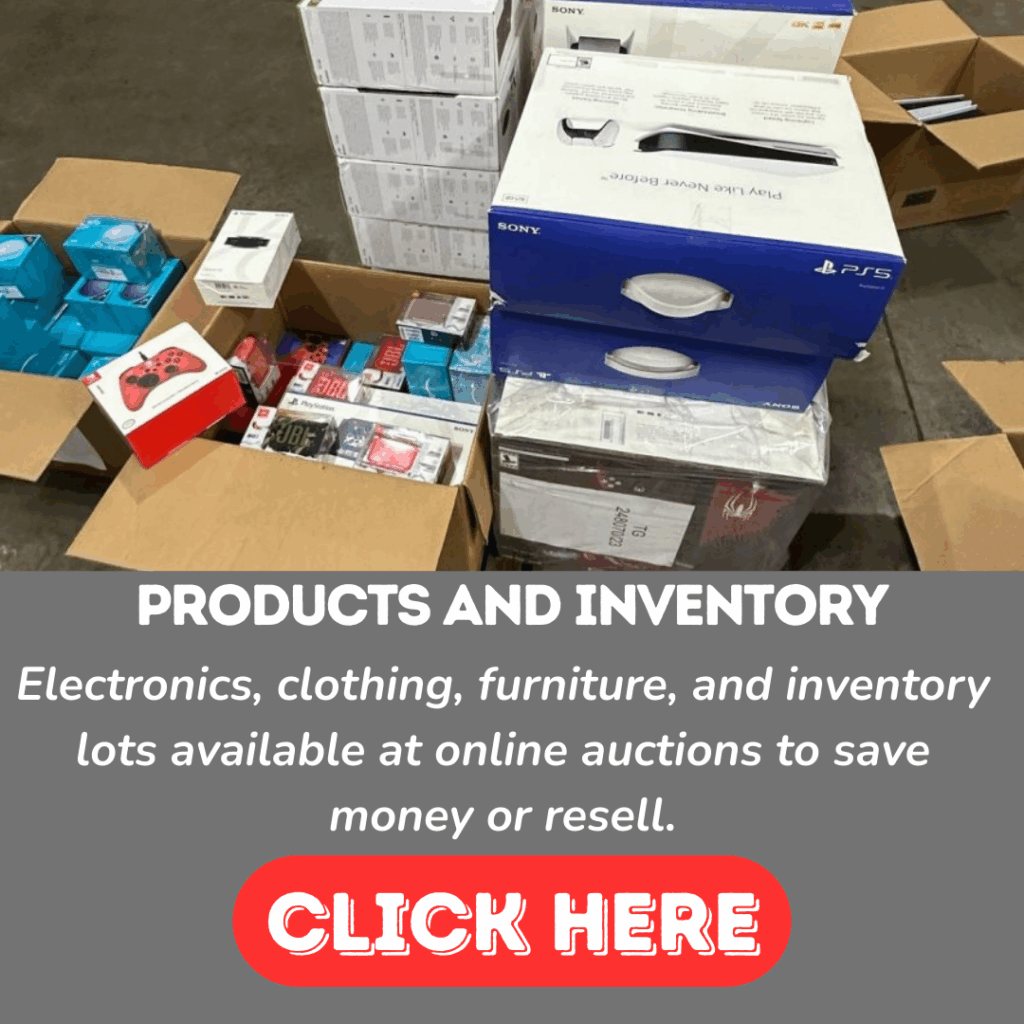How an In-stock product auction works and why you should join
You want great deals on items that are ready to ship.
An In-stock product auction sells products already in inventory — no supplier restock wait.
You find a listing, register, place a bid, and if you win, pay and collect or get it shipped. The process is simple, fast, and transparent.

Why join an In-stock product auction?
- Prices often fall well below retail because sellers clear inventory quickly.You can buy single units or bulk pallets of new, like-new, returned, or overstock items.With a plan, auctions serve home needs, resale, or gifts.
- Auctions expose deals the general public rarely sees.
Know the platform rules, fees, and timelines so you bid confidently. Read condition notes, inspect photos, and check seller ratings to avoid surprises.
Live auction deals vs flash sale auctions you can expect
Live auctions run in real time with a host or automated clock. Bidding moves fast and emotions can push prices up. Flash sale auctions are timed, short events (hours or a day) that list many items and often clear stock quickly. Flash sales favor pre-planned bidding and proxy bids.
Where you’ll see each:
- eBay: timed auctions and occasional live events.Liquidation.com and B-Stock: timed pallet and lot auctions.
- GovDeals: timed or live events for government surplus.
Read terms: some live auctions allow phone bidding; flash sales may require pre-registration or deposits.
Limited-stock bidding basics to help you win
When stock is limited, be decisive and methodical:
- Read the lot description for condition, counts, and defects.Inspect photos closely; match serial numbers if provided.Check shipping and pickup rules (local pickup vs pallet freight).Set a clear budget including fees and shipping, then stick to it.Review seller history and ratings.Watch bidding patterns to time your move.
- Act quickly when the lot matches needs and price.
What to expect during US online product bidding discounts
Expect real savings, plus extra costs:
- Buyer fees (buyer’s premium), shipping, and sales tax can add significantly.Condition notes are common, but many liquidation lots are as-is.Pickup windows and payment deadlines (often 24–72 hours) are strict.Hot items (electronics, brand names) attract competition.
- Pallets and lots can be profitable for resellers who handle repackaging.
Manage risk by reading listings, asking questions, and choosing sellers with strong track records.
Where to find In-stock product auction listings in the United States
You’ll find In-stock product auction listings online and locally. Compare lots and fees across sources:
Major platforms:
- eBay: single items, bulk lots, buyer protection on eligible sales.B-Stock: retailer liquidation marketplaces for pallets and cases.Liquidation.com: pallets, truckloads, and single items with shipping filters.
- GovDeals and GSA Auctions: government surplus and vehicles.
Also check AuctionZip, ShopGoodwill, and PropertyRoom for niche lots. Read each site’s rules and fee schedules.
How to check schedules and live auction deals near you
- Use platform calendars and search by city, ZIP, or state.Follow local auction houses on social media and email lists.Sign up to retailer liquidation portals for timed-event alerts.Set calendar reminders for pre-bid windows, start times, and pickup dates.
- Call auction houses ahead if you plan phone or in-person bidding.
Tips to spot urgent clearance auctions on U.S. sites
Look for final clearance, closeout, store closing, or one-day only. Other signals:
- Pickup-only listings with strict removal dates.Low starting prices vs similar lots.
- Sellers listing many similar lots quickly. Use saved searches with keywords like closeout, clearance, and overstock to catch urgent In-stock product auction deals early.
Bidding strategies to help you grab hot deals before they sell in an In-stock product auction
Tactics and discipline win deals:
Sniping vs early bidding
- Sniping: last-second bids (5–10 seconds) in timed auctions to prevent responses.
- Early bidding: strong early bids to deter casual bidders or claim unclaimed lots. Use sniping for fixed-close auctions and early bids when buyer interest looks low.
Setting a max bid
- Calculate a top price including buyer fees, taxes, and shipping.Use proxy bidding where available to keep your maximum hidden.
- If new info lowers value (damage or missing parts), adjust your maximum downward.
Smart timing
- Study closing patterns and use countdown tools.Pre-bid small to test interest.
- In anti-sniping auctions (time extensions), favor steady incremental bids instead.
Use real-time deal alerts so you never miss an In-stock product auction
Enable alerts to act faster than casual buyers:
- Mobile apps: eBay, Liquidation.com, and B-Stock push notifications for saved searches.Email digests: daily summaries for pallet marketplaces.
- Browser and SMS notifications for last-minute reminders.
Filter alerts tightly (brand, condition, lot size, location) to avoid alert fatigue and focus on relevant In-stock product auction opportunities.
How to set filters for live auction deals and flash sale auctions
Save searches using:
- Category and condition filters (new, like-new, returned).Location filters for local pickup or nationwide shipping.Price ranges to remove irrelevant lots.Seller filters to follow trusted sellers.
- Keyword includes and excludes (e.g., include model numbers, exclude as-is).
Save multiple searches for different buying strategies.
Real examples of online product bidding alerts in US services
- eBay: saved search Nintendo Switch console new alerts you to low starting prices.B-Stock: retailer marketplace digest highlights pallets and freight terms.Liquidation.com: mobile push on high-value returned smartphones.GovDeals: SMS for municipal fleet auctions with pickup locations.
- Local auction house email: weekly schedule with item highlights.
These alerts turn passive searches into active hunts for In-stock product auction bargains.
Know the risks, fees, and protections before you join an In-stock product auction
Costs beyond the hammer price:
- Buyer fees: often 5%–20% on liquidation sites.Sales tax: may apply depending on seller nexus.Shipping and freight: pallets can be costly and require liftgate service.
- Payment processing fees and possible storage charges for missed pickups.
Protections and returns:
- Many lots sell as-is; returns are rare for liquidation and government auctions.For branded items, request serial numbers and authenticity proof.Save listing pages, photos, and messages to support disputes.
- Use buyer protection (eBay) or credit cards for additional recourse where available.
Steps to protect your purchase:
- Read the full listing and fine print.Ask questions before bidding.Verify seller identity and ratings.Document listings and communications.Plan shipping/pickup and book freight in advance.Use secure payment methods when possible.
- Inspect on arrival and photograph discrepancies.
How to prepare to pay, pick up, and receive items from an In-stock product auction win
Payment and deadlines:
- Expect payment windows of 24–72 hours.Smaller lots often accept credit cards; large B2B lots may require ACH or wire transfers.
- Confirm wiring instructions to avoid scams.
Shipping, pickup, and inspection tips:
- Request tracking for shipped items.For pallets, book a freight carrier with liftgate if needed.For local pickup, bring tools, straps, and helpers; bring ID and any required paperwork.
- Inspect before signing release; document damages immediately.
Checklist to complete your purchase and claim last-chance auction items
- Confirm the win and read the invoice.Note payment deadline and accepted methods.Calculate total cost: hammer price buyer fees tax shipping.Make payment and save confirmation.Book shipping or freight.Confirm pickup hours and ID requirements.Bring tools and helpers to collect heavy lots.Inspect, photograph, and document condition on pickup.File disputes within the platform’s window if needed.
- Store items safely or prepare them for resale.
Following this checklist turns an In-stock product auction win into a smooth, profitable transaction.
In-stock product auction final notes
In-stock product auction hunting rewards planning, discipline, and fast action. Use alerts, study listings, and set firm budgets. With the right approach you’ll consistently find inventory for personal use or resale at attractive margins.

